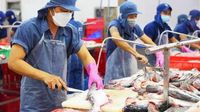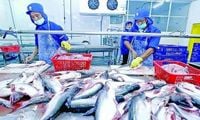As the U.S.-China trade war intensifies, Vietnamese seafood exporters are presented with both opportunities and challenges. According to the Vietnam Association of Seafood Exporters and Producers (VASEP), businesses are advised to diversify their markets and avoid over-reliance on any single one, particularly as the U.S. market remains pivotal for Vietnamese seafood.
Ms. Le Hang, Director of Communications at VASEP, noted that the escalating trade tensions between the U.S. and China—where the U.S. has imposed a staggering 125% tariff on Chinese imports, and China retaliated with an 84% tax on U.S. goods—could bolster Vietnam's position in the U.S. market. However, this also poses a significant challenge as China, the world's largest seafood producer, may shift its focus to other markets, potentially altering the seafood trade landscape.
With China expected to reduce its seafood imports to 4.4 million tons in 2024 from 4.6 million tons in 2023, countries like India, Ecuador, and Vietnam are gearing up for fierce competition to capture market share in the U.S. and EU. Vietnam, which currently exports approximately $1.8 to $2 billion worth of seafood annually to the U.S.—accounting for about 20% of its total seafood export value—stands to benefit from stable demand among American consumers for shrimp and pangasius.
Yet, the challenges are formidable. While Vietnam aims to increase its exports to the U.S., it must also contend with China ramping up its seafood exports to the EU and Japan, where Vietnam holds market shares of 15-17% and 14-15%, respectively. Ms. Le Hang emphasized that to capitalize on the opportunities presented by China's market shifts, the Vietnamese seafood industry should focus on key products such as shrimp, pangasius, and tuna, and engage in value-added processing to fill the gaps left by China.
Furthermore, VASEP highlights the importance of negotiating with the U.S. to avoid anti-dumping duties and to provide transparent data regarding product origins and costs. Diversifying markets beyond the U.S. and China is also crucial, with a push to enhance exports to the EU, Japan, and South Korea through various free trade agreements (FTAs) like the EVFTA, CPTPP, and RCEP.
For example, Vietnamese shrimp entering the EU is exempt from tariffs, while Chinese products face tariffs ranging from 12% to 20%. Expanding into new markets, including the Middle East and South America, will also help mitigate risks.
The Department of Fisheries and Fisheries Control (Ministry of Agriculture and Rural Development) has issued directives to coastal and inland provinces in the Mekong Delta, urging local producers to remain calm and avoid panic harvesting or limiting production, which could disrupt growth targets. They are encouraged to optimize production chains to enhance productivity and product quality while implementing cost-reduction measures and ensuring traceability to avoid allegations of fraud regarding product origins.
Mr. Tran Dinh Luan, Director of the Department of Fisheries, indicated that the seafood industry aims for a growth target of 4.35% this year, a significant challenge amid global market uncertainties. However, positive indicators from key products like shrimp and pangasius, particularly with shrimp growth exceeding 37.8% in the first quarter, provide an optimistic foundation for the year ahead.
In the first quarter of 2025, seafood export turnover reached $2.45 billion, marking a 26% increase compared to the same period last year. Notably, exports to the U.S. exceeded $500 million. With the U.S. being the top import market for shrimp and tuna, and the second-largest for pangasius, it is crucial for Vietnamese exporters to maintain strong ties with American consumers.
Currently, over 400 Vietnamese businesses are exporting seafood to the U.S., with large orders in transit. Approximately 37,500 tons of various seafood products are currently en route to the U.S., with an additional 31,500 tons expected to be shipped in the latter half of April 2024. The recent 90-day suspension of countervailing duties by the U.S. has had an immediate positive impact, prompting a surge in seafood orders and increased operational capacity among processing companies.
Ms. Le Hang remarked, "The suspension of the 90-day tax is creating an opportunity to expedite exports, avoiding the risk of prolonged inventory. The seafood industry is hopeful for the outcome of negotiations with the U.S., aiming for a reduction or even elimination of countervailing duties, which would be ideal for our market strategy." She emphasized the need for businesses to restructure their strategies and seek alternative markets and partners to build resilience.
Furthermore, Mr. Phan Hoang Duy, Deputy General Director of Can Tho Seafood Import-Export Joint Stock Company (Caseamex), noted that the U.S. market is critical for their operations, accounting for over 50% of their total output. He explained that the U.S. tariffs on Chinese imports could indirectly benefit the Vietnamese seafood industry, as it may lead to a shift in demand.
During a recent meeting organized by the People's Committee of Can Tho City, local businesses discussed the implications of U.S. countervailing duties. Currently, 22 companies in the region are exporting to the U.S., focusing on key products such as rice, seafood, and processed agricultural goods. Many companies are now planning to adjust and expand their market reach, particularly during the three-month period of postponed countervailing duties.
Statistics from the Vietnam Chamber of Commerce and Industry in Can Tho indicate that approximately 80 businesses in the Mekong Delta are exporting to the U.S. A survey revealed that 84% of businesses are concerned that the new tax policy will directly impact their 2025 business plans. The most significant challenges identified include technical barriers, particularly regarding product quality and traceability.
As the seafood industry navigates these turbulent waters, the hope remains that diplomatic efforts will yield favorable results, allowing Vietnamese products to maintain their competitiveness in the global market.






